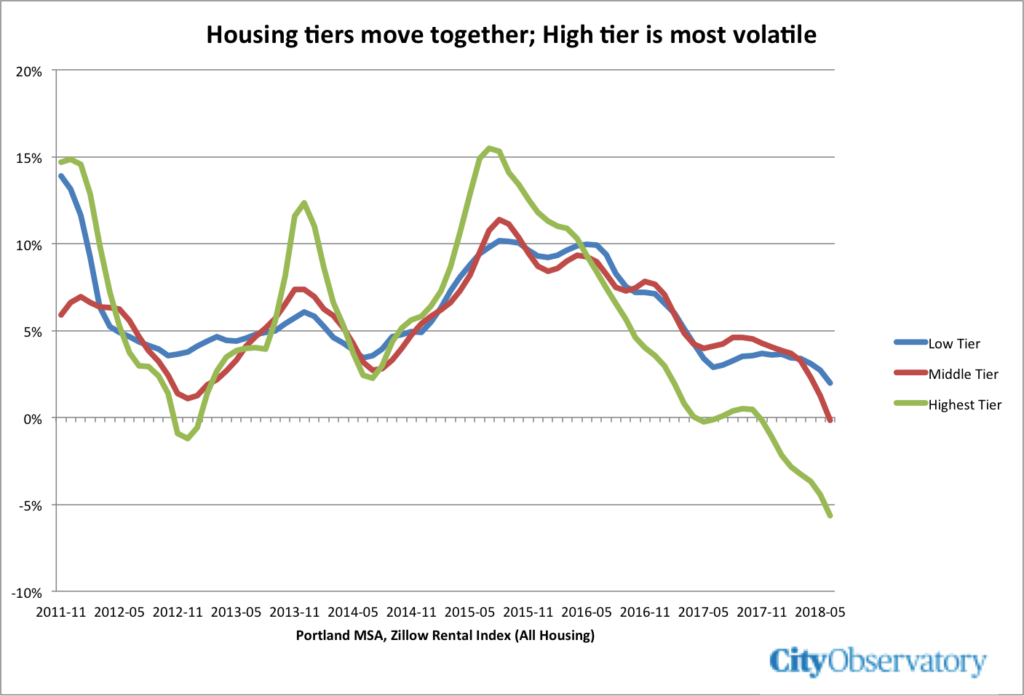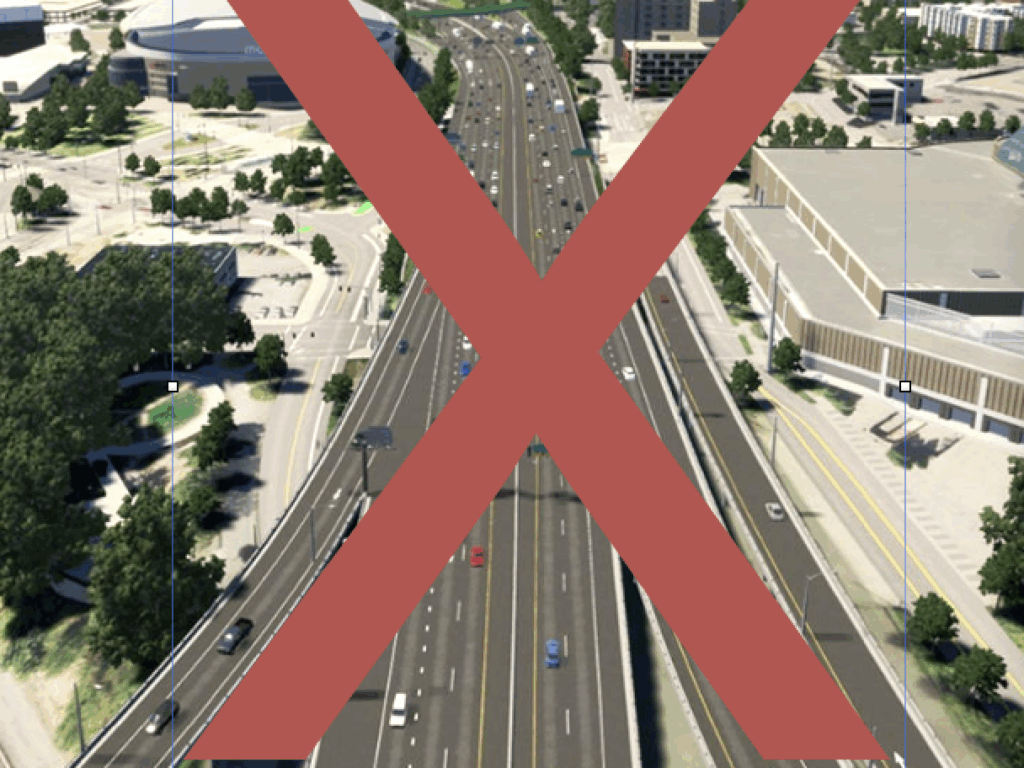What City Observatory did this week
1. We disagree with the Washington Post on housing economics. Two weeks ago, the Washington Post published an article claiming that rents were going down for higher income renters but increasing for lower income renters. That didn’t square with our reading of the data, so we took a closer look. It turns out that the data used in the Post’s story don’t include apartments. But perhaps more importantly, the data they use (generated by Zillow, and estimating how much single family homes, condos and coops would sell for if they were rented, even though most aren’t) show that rents in different income tiers tend to move in tandem over time. In Portland, the city highlighted in the Post article, rents in the highest and lowest tiers were actually strongly correlated. That’s a strong sign that what happens in one part of the market ultimately affects other parts of the market. And although the article implied that the construction of new, higher tier housing had no effect on rents, data for Portland show that rent inflation declined sharply in all tiers when new apartment construction surged after 2015.
2. Is St. Louis gentrifying? In a guest commentary for City Observatory, the University of Missouri at St. Louis’s Todd Swanstrom take a close look at the use of the word gentrification to characterize neighborhood change in St. Louis. It’s important to keep in mind that over the past several decades, the city of St. Louis has lost a majority of its population. That leaves considerable room for urban neighborhoods to add population without displacing anyone. It seems like gentrification has become “the g-word”–a general purpose epithet to express displeasure with inequality.
3. How can we save the heartland? Much of rural America, and many smaller cities and metros are either economically lagging or in decline. A new book from James and Deborah Fallows, based on their observations from barnstorming small places in their Cessna, points to strategies that have worked in some places. Bloomberg’s Noah Smith highlights a couple of the best approaches: build on a local university, and encourage innovation. While that can work in some places, we question whether it can work in enough places, much less everywhere to reverse rural decline. And please save us from invocations of that tired chestnut “public private partnerships.” Our most powerful rural policies probably turn out to be social security and medicare, which keep an aging rural population in place.
Must read
1. Philadelphia Playstreets. If you’re a kid from a middle class family, maybe you get to spend your summers at camp, or at summer school. But kids living in low income urban neighborhoods have fewer opportunities. Philadelphia has a great program, “Play Streets” that blocks off city streets for use as supervised play spaces for neighborhood kids. It cleverly combines this with support from the school lunch program to provide meals (and attract children). It’s a reminder that city streets can do much more than serve as conduits or storage space for cars; used wisely they can actually contribute to the civic commons.

2. More Philadelphia Streets: Block Parties. Summer is a time for block parties in the city. It’s another classic example of how we can expand the civic realm and build community. In general Philadelphia makes it pretty easy: you need a neighborhood petition with 30 signatures and a $25 fee and you can close your local street for a day-long event. But in some neighborhoods, there are concerns that block parties may trigger confrontations that lead to violence, leading Philadelphia police to ban block party permits in some places (chiefly near locations where there’s been a recent shooting, or where the police have concerns about traffic effects). Police department discretion to approve or deny permits raises some concerns: it may have a chilling effect on the willingness of some neighborhood residents to hold a block party at all. The Philadelphia Inquirer’s Julia Terruso talks about what’s happening on the streets.
3. Where the city is outstripping its suburbs: Seattle. The Seattle Times Mike Rosenberg has another terrific analysis of the local housing market, this time looking at the city vs. suburb pattern of housing construction in Seattle. For decades, most new homes (apartments and single family) have been built in the suburban portion of Seattle’s King County. But in this decade, that’s gone into reverse: suburban building is down sharply, and city building is up, with the result that more new homes have been built in the city of Seattle than those suburbs.
There’s a lot to unpack here. A big part of the explanation is the huge demand for urban living in downtown Seattle, thanks both to the presence of jobs (Amazon, et al) and one of the nation’s premiere urban environments. The decline of the suburbs undoubtedly reflects some combination younger adults disenchantment with suburban lifestyles, and suburban restrictions on new housing, especially apartments. What’s striking is that even though rents are up dramatically in Seattle, so far, development in its suburbs has done little to meet the demand for additional housing.
New Knowledge
A detailed database on urban violence. Patrick Sharkey has a new website-AmericanViolence.org, with an on-line database compiling crime statistics from the nation’s largest cities. Sharkey also has a new report based on the center’s data, entitled “Are U.S. Cities Getting More or Less Violent?” Spoiler alert: US cities are far safer today than they were one or two decades ago. While there have been some short-term fluctuations in murder rates, the unequivocal long-term trend has been downward. This map shows that only a relative handful of cities, including Baltimore and St. Louis. have experienced an increased murder rate since the crime-peak of the 1990s. On the map below, green represents a decline in the murder rate through 2017; orange represents an increase.
The report looks at both long and short term tends in murder rates across cities. While the long term trend has been down, the report confirms that murder rates moved upward between 2014 and 2017, but then have trended downward in the last 12-month period for which data are available. As the report concludes:
. . . the recent increase in violence does not compare in scale or breadth to the fall of violence that has taken pace since 1991. The recent rise of violence has barely made a dent in the long-term crime decline.
In the News
GreenBiz republished our essay “The Limits of Data-Driven Planning,” pointing up the car-oriented status-quo bias of reliance on big data.
The Waterloo-Cedar Falls Courier cited data from our report Less in Common, about how little interaction we have with our neighbors, in a story describing how neighbors called ‘911’ in response to an 11-year old girl’s lemonade stand.
Strongtowns republished our commentary on New York City’s wrong-headed decision to cap the number of Uber and Lyft vehicles in the city.




